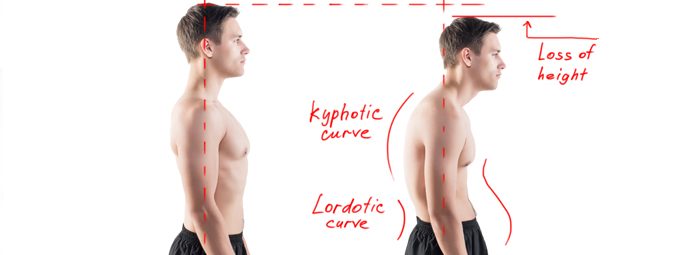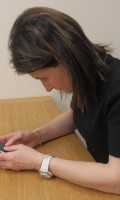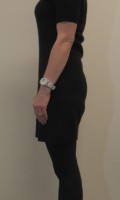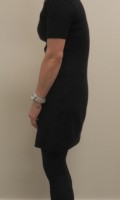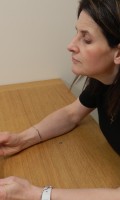Develop a good posture and reduce future physical problems with ‘Postural Correction Therapy’ from Paragon Physiotherapy
Your posture is very important. Having a bad posture either in standing, sitting or lying can lead to tightness, stiffness and pain, as well as predisposing you to injuries. Posture is the natural position you tend to put yourself into when holding yourself up against gravity. If you have good posture then your body will be doing very little work and there will be little strain placed on supporting muscles and ligaments.
Good posture doesn’t come naturally to all people. Most have some sort of bad habit they adopt when standing or sitting especially. These bad habits lead to learnt motor patterns which our bodies use to do even the simplest of things such as standing. Hence, we learn how to slouch and from then on it becomes a learnt habit.
Correcting your posture may feel awkward initially which may cause you to stop trying. This is because your body has become used to sitting and standing incorrectly. It takes a while to retrain your body to accept the correct positioning, but with certain strengthening and stretching exercises it can be done. After a while it will become second nature and you will protect your back for years to come.
After you have had your posture assessed your physiotherapist can help you put into practice certain exercises and movement patterns to combat learnt habitual patterns.
- If you recognise any of the poor posture images below in yourself you should ask for an appointment with us.
Click on the images below for a larger view.
If you work on a computer, you may find yourself adopting a poor posture such as hunching over your keyboard. Your head may lean forward, which will cause stiffness and pain in the neck. Using your smart phone to text or other activities can also encourage you to hang your head and can cause similar problems that physios call ‘text neck’. This is an indication that you have tight chest muscles and weak, over lengthened upper back muscles. Over time, this type of posture can contribute to you developing a rounded upper back, a condition called kyphosis, which can cause shoulder and upper back stiffness and pain
If you tend to stick your bottom out when you stand then you may have a pronounced curve in your lower back called ‘hyperlordosis’. This can be caused by tight back muscles and hip flexors in addition to weak hamstrings, buttocks and core muscles. The effect is to tilt your pelvis forward and can give you back problems. Contributing factors could be anything that makes you lean forward such as excessive weight around the middle, pregnancy and wearing high heels a lot.
If your back is flattened when you stand then your pelvis will be tilted back leading to a loss of the naturally occurring curve in your lower back, resulting in a stoop. If you persist with this posture you will develop back pain and find it increasingly difficult to stand for long periods. This posture is often caused by muscle imbalances which encourage you to adopt such a position. Tight hamstrings and overactive core muscles as well as weakness in the front of your legs all contribute to this type of stance. Left untreated it will result in a painful neck and back in the future.
Sitting in a slumped position without any lower back support, may sometimes feel more comfortable than sitting upright. This is because it requires muscle work but unfortunately it will put a lot of pressure on your lower back resulting in problems for the future. One reason you may slouch in the first place is because you already have weak core muscles.
In this posture, your pelvis is not level, and your lower back is taking a lot of strain to support the weight of your upper body. The muscles that should be working to support you are inactive. Persistently sitting in this way could leave you with a hunched back. Get into the habit of sitting correctly. Sitting properly may not feel comfortable to start with because your muscles have not been deconditioned. Exercises to strengthen your core and buttock muscles and back extensions will help correct a slouching posture.
We all do it don’t we? It feels natural but sitting with your legs crossed puts pressure on your lower back. This position, tucks your hip in and causes you to slouch. Over time you may develop muscle imbalances in your hips which can cause stiffness and pain in the hips and low back. Bad habits are hard to change as your body becomes accustomed to the position, but your back will seriously suffer if your keep sitting this way.
Many people poke their chin forward to look up at a computer screen or TV when sitting without even realising it. The poking chin posture is mostly caused by sitting too low or a screen set too high or t could be you already have a hunched back which is slumping you forward so you have to poke your chin to look up. This hunched upper back or an unsupported lower back cause the head to lean forward. To compensate, we lift the chin to look forward without straightening the back.
A poking chin posture can lead to muscle weakness around the neck and compression of the neck joints, which over time can lead to stiffness, pain in the neck, pain in the shoulders and upper back and cause headaches.
Sometimes referred to as ‘hanging on one hip’. It can feel comfortable, especially if you’ve been standing for a while and you feel like taking the weight of certain areas, but people who tend to do this do it as a result of weakness in some muscles. Instead of using your buttocks and core muscles to keep you upright, you place excessive pressure on one side of your lower back and hip.
Over time, you will develop muscle imbalances around your pelvis area, leading to uneven hips which can cause excessive muscular strain and pain in the low back and buttocks.
Holding your phone handset between your ear and shoulder places undue stress on the muscles of the neck, upper back and shoulder. If you always cradle the phone on the same side, it will shorten, compress and weaken the neck muscles on one side while stretching the muscles on the opposite side. It will also compress the joints of the neck leaving you more susceptible to arthritis in this area.
The neck and shoulders are not designed to hold this position for any length of time can cause result in headaches and stiffness and pain in the neck, shoulders and arms.
Carrying a bag on one side of the body can wreak havoc on your posture and cause injury.
Carrying heavy bags on one side of your body can stretch supporting muscles and ligaments, which can affect the back and shoulder alignment which in turn can cause posture-related stiffness and pain. Even carrying heavy bags in both hands to try to level yourself up can cause stretching of soft tissue and even cause traction of the nerves that run down your arm. This will cause pins and needles or even numbness to develop.
Carrying a bag on one side of the body can wreak havoc on your posture and cause injury.
Carrying heavy bags on one side of your body can stretch supporting muscles and ligaments, which can affect the back and shoulder alignment which in turn can cause posture-related stiffness and pain. Even carrying heavy bags in both hands to try to level yourself up can cause stretching of soft tissue and even cause traction of the nerves that run down your arm. This will cause pins and needles or even numbness to develop.

